1. Essential Supplies for start Indoor Container Garden

Starting an indoor container garden can be a rewarding experience, offering fresh greenery and homegrown produce at your fingertips. Over the years, I’ve discovered the essentials needed to create your flourishing green sanctuary.
Containers and Grow Bags
First, choose containers or fabric grow bags that provide excellent drainage for your plant needs. Initially, I started with decorative pots that were too small but It doesn’t fit all types of plants that grow inside our home. Especially large plants like tomatoes need at least 12 inches of in-depth Containers.
Select a Range of Containers
- Use ceramic pots for herbs.
- Choose lightweight grow bags for larger plants like tomatoes.
- Ensure the container size matches the needs of your plants.

High-Quality Potting Soil with Proper Drainage
Invest in high-quality potting soil specially designed for container gardening. Avoid using garden soil as it can compact and hinder growth—look for potting mixes with perlite or vermiculite to ensure proper aeration.
Invest in Quality Potting Soil
- Look for soil that offers excellent drainage.
- Enhance it with perlite or vermiculite to improve aeration.
- Avoid inexpensive soil, as it can lead to unhealthy plants.

Seeds or Starter Plants for Your Indoor Vegetables and Herbs
When it comes time to choose between seeds and starter plants, each option has its unique advantages. Seeds provide a wider variety of choices. You can mix both seeds and starter for best results
Decide between seeds and starter plants
Seeds : Perfect for herbs and best for to grow from scratch
Starters: Its suit best for more challenging varieties or if you prefer a jumpstart.
Organic Fertilizer for Container Plants
Organic fertilizers are essential for replenishing nutrients and it is safe for your plants and household. In my experience, slow-release pellets offer consistent feeding while liquid forms give quick boosts when needed.
Use organic fertilizer
- Adhere closely to application instructions.
- Refrain from over-fertilizing; more isn’t always better.
- Be mindful of different nutrient requirements for various types of plants.
Watering Cans or Self-Watering Planters
Proper watering is essential for a healthy garden. Overwatering and underwatering can harm your plants. A watering can with a narrow spout helps control the flow. Self-watering planters are a great option if you forget to water your plants on time. I prefer using self-watering for hungry plants and a can for delicate ones. Balance is essential for making a plant’s happy and steady growth.
Watering Smartly
- Get a reliable watering can that allows for precision.
- Consider self-watering planters if you tend to forget about watering schedules.
- Learn how to interpret your plant’s hydration needs: drooping leaves may signal too much or too little water.
- For accuracy, use a soil moisture meter.

Grow Lights for Low-Light Areas
Not all indoor spaces have enough natural light. Grow lights made a big difference for me. I thought direct sunlight through windows was enough to grow, but my plants struggled a lot. So I found an alternative solution if you don’t have proper sunlight.
- LED grow lights extend your growing season and are energy-efficient.
- Full-spectrum lights mimic sunlight best.
- Grow lights give your plants the boost that is required in dark corners.
Don’t underestimate the importance of a few handy tools. Pruning shears help keep plants tidy and encourage growth, while a soil moisture meter takes the guesswork out of watering.
- Pruning shears are essential for plant care.
- A moisture meter prevents over or under-watering.
- These small tools make a big difference.
By following these steps and using the right supplies, you’ll be well on your way to a thriving indoor garden. It’s all about learning what works for your space and plants.
2. Choosing the Right Plants
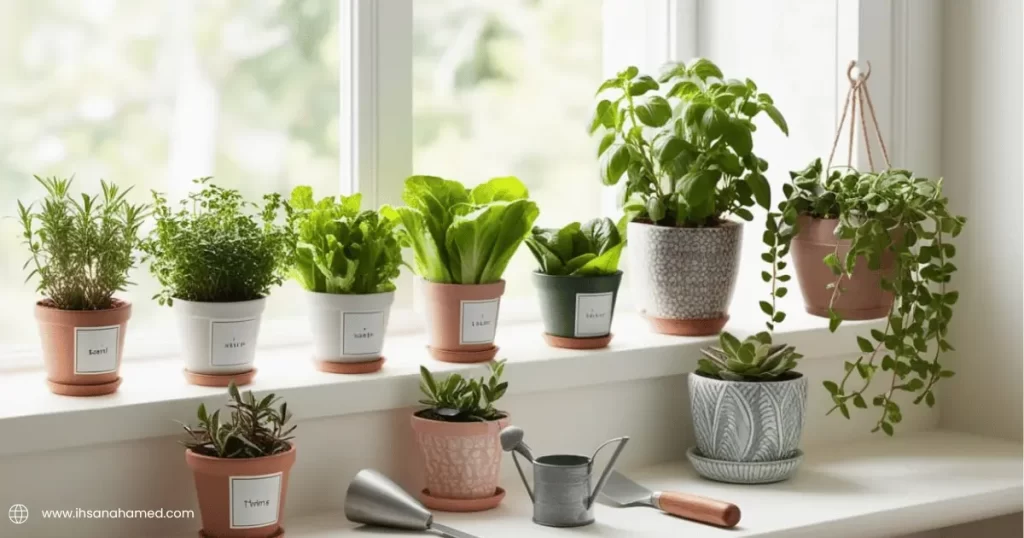
Starting a small space garden can be a good choice and rewarded. Especially when you choose the right plants to grow. If you are looking into fresh herbs for your meal or you want to enjoy the experience of green Homes in limited spaces.
Herbs for Your Kitchen Herb Garden
When it comes to herbs, fresh basil, mint, rosemary, and thyme are readily available. These varieties are well-suited for small gardens and thrive indoors
Basil: Thrives in warmth and sunlight; place it on a bright windowsill.
Mint: Grows rapidly and can spread out, so it’s best to keep it in its own container.
Rosemary and Thyme: Both prefer well-drained soil with ample light.

These herbs are not only helpful for your dishes but also bring a memorable fragrance to your Home.
Indoor Vegetables: Cherry Tomatoes, Lettuce, Microgreens
You will face a few challenges at indoor growing when you just getting started but it will be feasible with the right selection of choices. My top recommendations are cherry tomatoes, lettuce, and microgreens.
Cherry Tomatoes: They require plenty of light, consider using a grow light if natural sunlight is limited. The joy of picking fresh tomatoes from their vine is unmatched!
Lettuce: rows quickly and doesn’t demand much light. You can harvest leaves individually for an ongoing supply.
Microgreens: These nutrient-rich plants grow swiftly—just scatter some seeds over the soil, keep them moist, and you’ll be ready to harvest within two weeks.
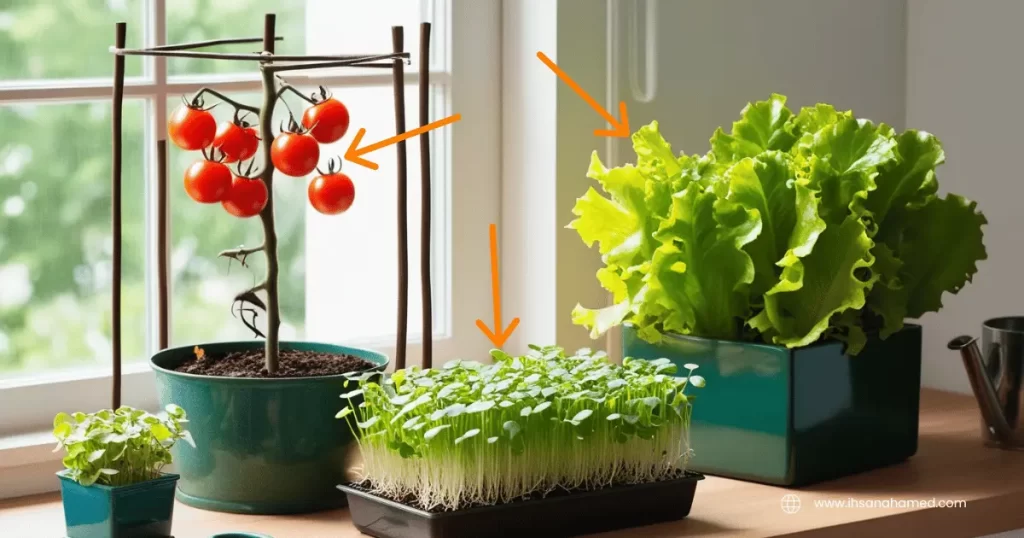
These vegetables are not only space-efficient but also easy to care for—perfect for those new to gardening!
Air-Purifying Plants: Pothos, Spider Plant, Snake Plant
If you feel your home is not getting enough air for your plants consider air-purifying plants such as pothos, spider plants, and snake plants.
Pothos: This plant is versatile and can thrive in various lighting situations while being low-maintenance.
Spider Plant: Preferring indirect sunlight, this plant can handle a bit of neglect quite well.
Snake Plant: Known for its resilience, it flourishes even in low light and requires very little watering.

These plants are perfect for adding greenery to your space without demanding too much attention.
consider a few options when choosing plants for small spaces
Light Requirements
Expose the natural light to your home. Some plants like basil and cherry tomatoes require plenty of sunlight. But snake plants can manage with less amount of sunlight.
Humidity Needs: Certain plants like thrive need humidity conditions to grow. If your home is dry consider using a humidifier or clustering your plants together to create a more favorable environment.
Growth Rate: Quick-growing options like microgreens offer instant gratification, while slower-growing varieties like rosemary may take more time but still bring their rewards.
3. Mastering the Art of Container Garden Layout

Creating a beautiful and effective container garden is a skill that blends practicality with style. When I first started, I felt excited but overwhelmed by all the options. Here’s what I’ve learned about arranging a container garden.
Size Considerations for Different Container Plants
Choosing the right container size is important for plant health. I learned when my tomatoes grow unshaped out of their pots.
Here’s what you need to know
Small Herbs: Basil and mint grow well in pots that are 6-8 inches deep. These herbs are perfect to place on windows for direct sunlight.
Medium-Sized Plants: Lettuce and leafy greens need at least 8-10 inches deep.
Large Plants: For bigger plants like tomatoes and peppers require 12 inches or more. I prefer using wider containers to give their roots plenty of room to spread out.

The key is to match the container size to the plant’s root system. Bigger plants need more space, so don’t be afraid to go up a size if needed.
Drainage Requirements and Solutions for Soil Drainage
Good drainage is essential in container gardening. Without it, plants can suffer from root rot. I learned this after a rainy week left my plants in soggy soil.
Here is what to do
Drainage Holes: Always make sure your pots have drainage holes at the bottom.
Pot Feet or Saucers: Elevating pots improves airflow and drainage naturally. I prefer using pot feet or placing pots on saucers with pebbles to remove excess water.
Soil Mix: Prefer using a potting mix for better drainage with perlite or vermiculite. Good drainage keeps your plants healthy.
Good drainage acts like insurance for your plants’ health.
Material Options: Ceramic, Plastic, Terra Cotta
The choice of container material significantly influences both the aesthetics and performance of your indoor garden.
Here’s a deeper look into three popular materials based on my experience
Ceramic: These pots are beautiful and come in many designs, but they can be heavy and break easily. Make sure they have drainage holes, or you’ll need to drill them.
Plastic: Lightweight and cheap, plastic pots are versatile and available in many styles. They hold moisture better than terra cotta, which can be good or bad depending on how you water.
Terra Cotta: A traditional option that provides excellent airflow for roots, though they dry out more quickly. I prefer using them for plants that thrive in drier environments like succulents.
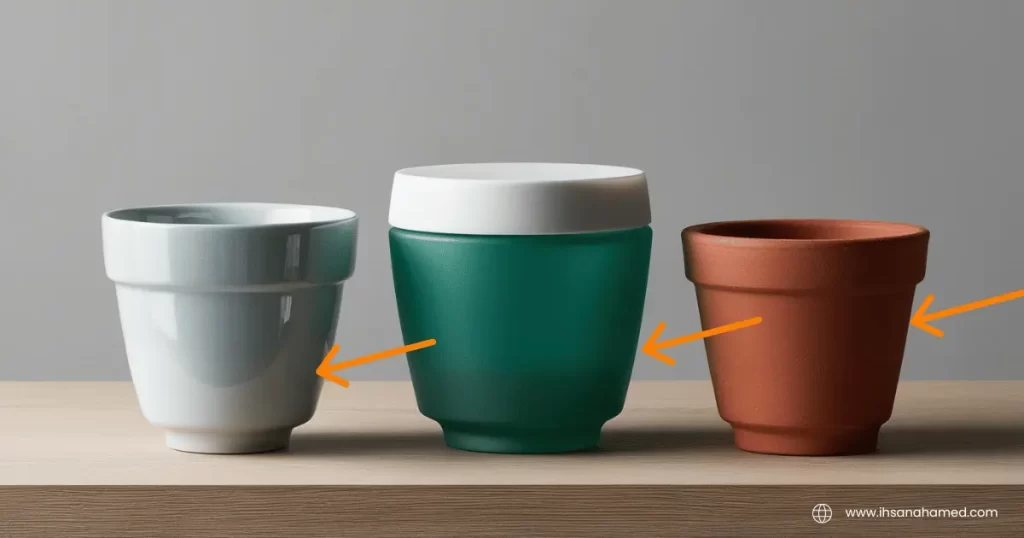
Choose materials based on where you’ll place your garden and how much maintenance you’re willing to do.
Balancing Decorative and Functional Containers for Indoor Gardens
When I start an indoor garden, I struggle to balance between decorative and functional containers. My home became a messy garden center until I found a better option.
Decorative: These pots can enhance your space and show your style, but they often don’t have drainage, so use them carefully. Sometimes, I prefer placing decorative pots over functional ones.
Functional: Focus mostly on fictional pots for your plants. I usually pick simple pots that work well and can add plant stands for stylish arrangements.
You can mix both types: use decorative pots for showcases and functional ones for everyday use.
4. Creating the Perfect Soil Mix for Container Plants

High-quality potting soil is crucial for starting an indoor container garden. After a few tests and trials, I have learned how to craft the best quality soil mix for your ideal plants.
Components of a Good Potting Soil
Good potting soil is essential for container gardening. It gives plants the nutrients, moisture, and air they need.
Here’s what to look for
Lightweight Texture: Potting soil should be loose and airy. I learned this when I used dense garden soil that compacted and stunted my plants. A lighter texture helps roots grow and prevents compaction.
Nutrient Content: Your soil should have organic matter like compost or peat moss for nutrients. I often add worm castings for extra nutrients.
Moisture Retention: ingredients like coconut coir or peat moss help keep moisture, so plants don’t dry out quickly.
Aeration and Drainage: Add perlite or vermiculite to improve aeration and drainage. These materials create space for air and water to move through the soil.

Once I used soil with these components, my plants looked healthier and grew faster. The right soil makes a big difference.
Importance of Proper Drainage in Container Garden Soil Mix
Proper drainage is important to avoid waterlogging in the roots. I have faced frustration when my basil plants fell victim to root rot due to poor drainage practices.
Here’s why drainage is essential
Prevents Waterlogging: Drainage holes in containers let excess water escape, keeping roots from sitting in water
Improves Airflow: Good drainage keeps the soil aerated, which is important for root health. Ensure your pots have drainage holes and use a well-draining soil mix. Adding a layer of gravel or pebbles at the bottom can also help.
Organic vs. Synthetic Soil Options for Sustainable Indoor Gardening
Choosing between organic and synthetic soil can affect your gardening sustainability.
I have tried both and here’s what I found
Organic Soil: Made from natural materials like compost and peat moss, organic soil supports a healthy ecosystem and is environmentally friendly. I prefer organic soil for its sustainability and natural nutrients.
Synthetic Soil: It contains fertilizers and organic materials and it can provide quick nutrients, they don’t support soil biodiversity as well as organic options. For sustainability growth organic soil is the better option. It promotes healthy plant growth and a healthy environment.


For those who prioritize sustainability, organic soil is the better choice. It promotes healthy plant growth while being kinder to the environment.
DIY Soil Mix Recipes for Optimal Plant Nutrition
Making your soil mix lets you customize it for your plants.
Basic Potting Mix
- 1 part peat moss or coco coir (for moisture retention)
- 1 part perlite or vermiculite (for aeration and drainage)
- 1 part compost (for nutrients)
Cactus and Succulent Mix
- 2 parts coarse sand or pumice (for drainage)
- 1 part potting soil (for basic nutrients)
- 1 part perlite (for extra aeration)
Herb and Vegetable Mix
- 2 parts peat moss or coco coir (for moisture retention)
- 1 part perlite (for good drainage)
- 1 part compost or aged manure (for nutrients)
5. Watering Techniques for Indoor Container Gardens

Watering indoor container vegetables can be challenging due to overly wet soil and unhappy plants. After testing and trial, we discovered an effective method. It is very crucial to recognize symptoms of overwatering or underwatering to ensure plants have the right moisture levels.
Signs of Overwatering and Underwatering
Recognizing symptoms of overwatering and underwatering is crucial for plant health. I’ve experienced frustration when my plants struggled, unaware of the underlying issues
Here’s what I’ve learned
Overwatering Signs: Watch for yellowing leaves, wilting, moist soil, and mold to prevent root rot in plants. I lost a basil plant due to missing these signs.
Underwatering Signs: Dry, brittle leaves and soil pulling from the pot indicate a thirsty plant. Regular checks on soil moisture and adjusting watering can prevent issues. A soil moisture meter simplifies this process.
Self-Watering Planters Options
Self-watering planters helped my indoor garden to provide consistent moisture levels by reducing the risk of over or under-watering, especially during busy times.
Wicking Systems: These utilize a wick to draw water from a reservoir into the soil—ideal for moisture-loving plants like ferns.
Sub-irrigated Planters: With a water reservoir at their base, these are perfect for thirsty varieties such as tomatoes and peppers as they provide consistent access to water without drowning them.

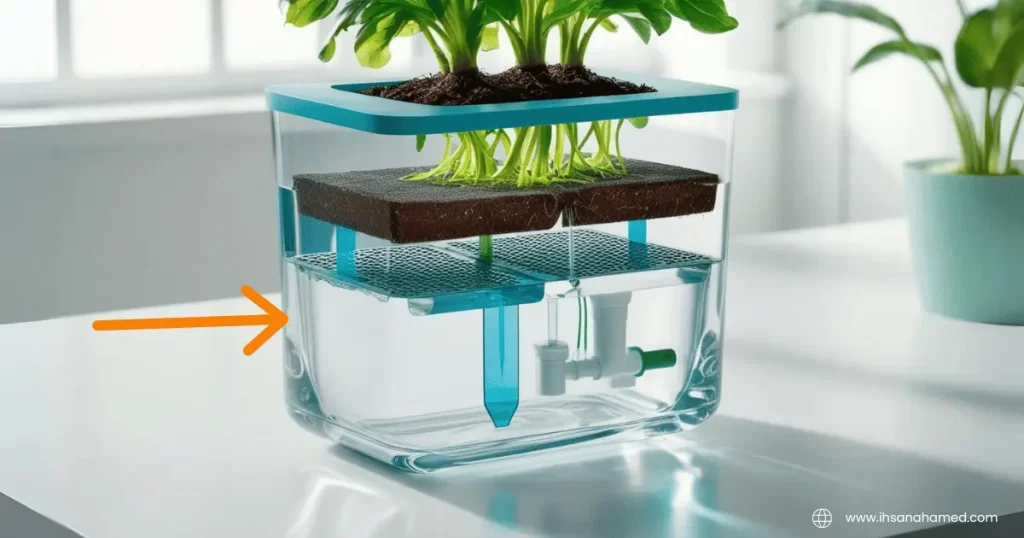
Using self-watering containers has given me peace of mind while keeping my plants thriving with minimal effort.
Watering Schedules for Different Plants
Different types of plants have a unique way of watering requirements. Understanding this is crucial for plant health. When I just started I thought all plants needed the same amounts of water.
Quickly realized that wasn’t true
Succulents and Cacti: These require less frequent watering; every two weeks works well for me as long as their soil dries out completely between sessions.
Herbs and Leafy Greens: Plants like basil and lettuce thrive on more moisture; depending on temperature and humidity levels, I usually water them every 3-4 days.
Flowering Plants: For species such as African violets, regular watering is necessary but they shouldn’t be left standing in water—I typically give them a drink once weekly.
Plant Humidity Considerations for Indoor Environments
Indoor spaces frequently have a chance of low humidity and it can lead to crispy leaf edges and insufficient moisture in the air. It is crucial to monitor and adjust humidity levels whenever required
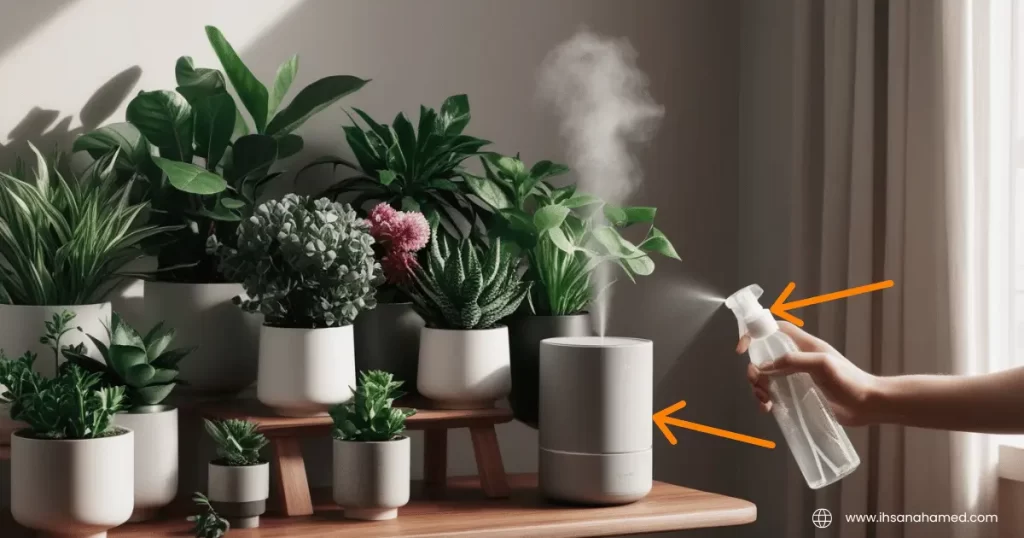
Group Plants Together: This approach helps create a microclimate that retains moisture better.
Use a Humidifier: Particularly during winter months when indoor air tends to be drier and can help maintain optimal humidity levels.
Mist Your Plants: Lightly misting humidity-loving species like ferns or orchids can enhance local humidity around them.
6. Troubleshooting Common Indoor Garden Problems

Indoor gardening can be rewarding, like any hobby and it comes with challenges. I have shared my indoor garden mishaps, from pesky pests to stubborn root-bound plants.
Here is a guide help you to troubleshoot a few common indoor garden problems with my tips based on my personal experience.
Indoor Garden Pest Control and Identification
Dealing with pests can be one of the biggest challenges for those who have started indoors. I have wasted my time with unwanted insects on my plants, and finally, I have discovered this.
Common Pests: Spider mites, aphids, and fungus gnats are common pests in indoor gardens. I once dealt with spider mites infesting my tomato plant, which harmed its leaves.
Identification: Regularly inspect your plants for issues such as leaf holes, sticky areas, or webs. A magnifying glass can assist in identifying small, hard-to-see pests.
Control Methods: For minor outbreaks, I use insecticidal soap or neem oil indoors. For serious issues, beneficial insects like ladybugs can effectively manage the problem.
Regular monitoring and effective action are crucial to keeping your indoor gardening home free from pests.
Plant Pruning and Maintenance Tips
Plant health becomes more healthy and beneficial after Pruning is an initial step of daunting. Try this if you are facing problems like unhealthy plants.

Why Prune? Pruning stimulates new growth, removes unhealthy plant parts, and maintains shape. For example, trimming basil encourages more leaf growth.
How to Prune: Use clean scissors or pruning shears for cutting. Trim just above a leaf node to promote bushiness in the plant.
Maintenance Tips: Regularly wipe plant leaves with a damp cloth to remove dust and improve breathing. Pruning enhances appearance and promotes healthier growth.
Pruning not only keeps your plants looking tidy but also promotes healthier and quicker growth
Repotting and Root-Bound Plants
Transplanting is essential to prevent root-bound plants. My pothos thrived after being moved to a larger pot.
Signs of Root-Bound Plants: To identify a root-bound plant, look for roots emerging from drainage holes, stunted growth, or wilting despite regular watering. These signs suggest that repotting is necessary.
How to Repot : To transplant, choose a pot 1-2 inches wider. Remove the plant from its old pot, gently untangle any circling roots, and place it in a fresh potting mix.
Timing: Spring is the best time to repot plants, as they can adapt during active growth. If a plant is root-bound, it’s advisable to report sooner.
Repotting provides your plants with the room they need to grow and allows them access to fresh nutrients in new soil.
7. Advanced Indoor Gardening Techniques
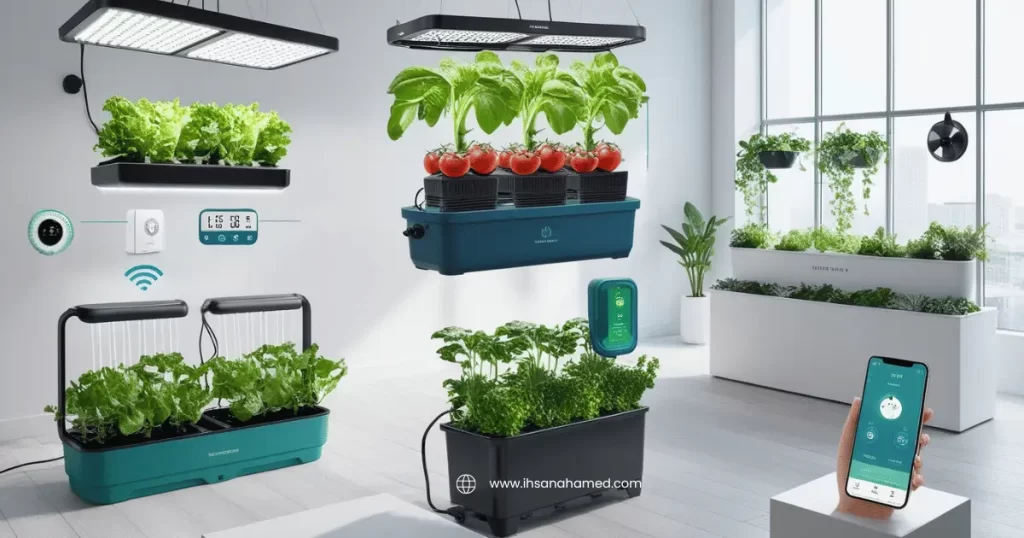
Cultivating plants indoors can be an incredibly rewarding pastime, particularly when you begin to experiment with more sophisticated methods.
Throughout the years, have tried out different approaches to improve my indoor garden, maximizing the use of my small space and available resources.
Let’s take a closer look at some advanced indoor gardening techniques that can really take your gardening skills to the next level.
Vertical Indoor Garden Ideas for Maximizing Space
Vertical gardening is ideal for maximizing limited indoor spaces. Personal experiments have transformed a small apartment into a lush retreat.
Here are some ideas to begin your vertical gardening journey

Wall-Mounted Planters: Installing wall planters or shelves allows for herbs and small plants, optimizing space. A vertical garden in the kitchen saves room and adds a natural touch.
Hanging Pots: Suspend pots from the ceiling or wall hooks for an attractive cascading effect. This method is ideal for trailing plants like Pothos and a string of pearls, which thrive when hung.
Stackable Planters: Stackable containers are perfect for maximizing space when growing multiple plants like lettuce and herbs. They utilize vertical height efficiently and ensure easy access to the plants.
Hydroponic Indoor Garden Setups
Hydroponics grows plants without soil and using nutrient-rich water. Initially daunting, it proves effective for indoor gardening.

Here’s how to set up your own hydroponic system
Deep Water Culture (DWC): In this method, plant roots are submerged in nutrient-rich water. DWC is preferred for leafy greens due to its rapid growth and straightforward nutrient access.
Nutrient Film Technique (NFT): The NFT method uses a thin nutrient solution layer over plant roots, ideal for herbs and small vegetables. It’s efficient and conserves water effectively.
Ebb and Flow System: The flood-and-drain system periodically floods growing trays with nutrient solution, then drains them. This method is adaptable and effective for different plant types.
Indoor Plant Propagation Methods
Propagation is an effective way to expand your indoor garden without purchasing new plants. By using different techniques, you can successfully multiply your existing plants, leading to a thriving garden without additional costs.

Cuttings: Taking cuttings from healthy plants and rooting them in water or soil is easy. This method works well for mint and basil, resulting in vibrant new plants.
Leaf Propagation: Succulents and some houseplants can be propagated from single leaves. Placing succulent leaves on soil can lead to new growth.
Division: Splitting the root ball of spider plants and peace lilies rejuvenates older plants and creates new ones.
Indoor Composting for Sustainable Gardening
I hesitated when I tried the first time but it can bring composting high nutrient-rich soil from kitchen wastes.
Here’s how to start
Choosing a Bin: Choose a small indoor compost bin, like a worm bin, to effectively reduce odour.
Materials: To compost effectively, mix green materials like vegetable scraps and coffee grounds with brown materials such as paper and cardboard. For convenience, use a small container in your kitchen to gather scraps before transferring them to the main compost bin.
Maintenance: Splitting the root ball of spider plants and peace lilies rejuvenates older plants and creates new ones.

Indoor composting helps cut down on waste while providing rich compost that benefits your houseplants, encouraging them to thrive.
Conclusion
Start indoor container garden is a fantastic way to enjoy gardening all year round, right from the comfort of your home. With a bit of knowledge, patience, and care, you can cultivate fresh salads, aromatic herbs, and vibrant houseplants.
Every expert gardener began as a novice; don’t be afraid to embrace the learning curve. DIY. Indoor gardening projects allow you to experiment and discover what works best for you.
When selecting soil for indoor container vegetables, choose a high-quality potting mix designed for container gardening. This will ensure proper drainage and nutrient availability. One common challenge in indoor gardening is managing to water your container vegetables.
Remember that over-watering can lead to root rot while under-watering can stress your plants. If you’re interested in growing tomatoes indoors, opt for cherry or grape varieties that thrive well in containers.
Start your urban gardening journey now; it’s an immensely rewarding experience that not only enhances your living space but also delights your taste buds with fresh produce.
What are the benefits of starting an indoor container garden?

Indoor container gardening allows you to grow fresh herbs, vegetables, and flowers year-round, improves air quality, and adds a touch of nature to your home.
What type of containers should I use for my indoor garden?
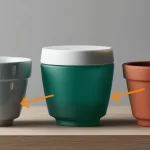
You can use pots made from plastic, ceramic, and terra cotta materials. Just ensure they have drainage holes to prevent overwatering.
How much light do indoor plants need?

Most indoor plants thrive with about 6-8 hours of indirect sunlight daily. Consider using grow lights if natural light is limited.
What types of plants are best for beginners?

Herbs like basil, mint, rosemary, and thyme as well as low-maintenance veggies like lettuce, cherry tomatoes, and microgreens are great choices for beginners
Do I need special soil for container gardening?

Using a high-quality potting mix designed for container gardening is recommended as it provides better drainage and nutrients than regular garden soil.







